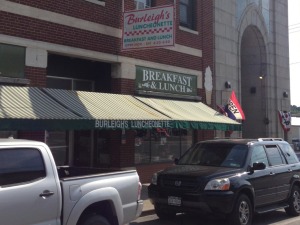At the crossroads of America
 The crossroads of America is right outside my Super 8 room in Ticonderoga. The Walmart in the rear is in full view of the window. Catty-corner across the intersection are the remains of a grocery store the Walmart must have cratered. McDonald’s, at Walmart’s entrance, advertises the kinds of job America is being built on these days. “Closing shifts, 8p – 1a, $6 an hour.”
The crossroads of America is right outside my Super 8 room in Ticonderoga. The Walmart in the rear is in full view of the window. Catty-corner across the intersection are the remains of a grocery store the Walmart must have cratered. McDonald’s, at Walmart’s entrance, advertises the kinds of job America is being built on these days. “Closing shifts, 8p – 1a, $6 an hour.”
There’s a Dunkin’ Donuts in a faux Colonial house-type building with faux chimney. Subway, the great bottom feeder of American retail, is in a building that definitely looks like it was something else before. Nearby are boarded up, run down and creepy, Pyscho looking motels of the old school. You know, the kind with an office at one end and a line of rooms—each with door, window, small bit of porch. At one of these, the weeds and vines grow up and around the motel section as two kids play in the grass in front. Looks like a family is living in the office part.
My favorite place is the 24/7 massive mini—so not really mini—mart and gas station across the street from the Super 8. I get all the candy, beef jerky, iced tea and other provisions I need to work. What work am I doing here?
In the mornings, I’m writing work-in-progress DROP DEAD PUNK, the second in the Coleridge Taylor Mystery series. In the afternoons, I shuttle the Boy Scouts of mighty Pelham Troop 1 to activities the troop does away from the camp. They need the dads to provide transport for some 40 or so scouts, so I turned this into a one-week writer’s retreat. Things are pretty productive here at the crossroads of America. I complete four chapters in one week, an all-time writing record for me. I get real motivation from having to finish a certain amount if I want to participate in the scout activities.
The second day I didn’t get to kayak, sitting instead at a picnic table at base camp banging away at the word count. That was motivation the following two days. I really wanted to attend the rodeo and go white water rafting.
This crossroads, symbolic as it seems of the recession the country’s been through, is appropriate to one of the themes in the book, which is set during the October and November days of 1975 when New York City almost went bankrupt and nearly dragged the country—and perhaps the world—into something far worse than what was already a bad recession. The only difference is other trusted institutions dragged us into this one.